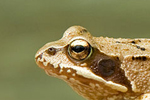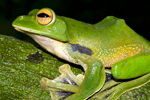
The starry shrub frog has been rediscovered after believed extinct for nearly 160 years. Photo by: L.J. Mendis Wickramasinghe.
In 1853 Edward Frederick Kelaart, a physician and naturalist, collected a strange frog on the island of Sri Lanka then a British colony known as Ceylon. The specimen was a large shrub frog (about 2 inches or 5.5 centimeters long) with black-outlined white specks on lime-green skin. He dubbed it “starry” after its pale specks, but that was last anyone heard of it. Even the holotype—the body of the amphibian collected by Kelaart—went missing. Fast forward nearly 160 years—two world wars, Sri Lanka’s independence, and a man on the moon—when a recent expedition into Sri Lanka’s Peak Wilderness rediscovered a beguiling frog with pinkish specks.
“These quite stunning frogs were observed perched on leaves in the canopy. They were slow moving, we collected samples which we thought were new species. But after reviewing past work, [especially] extinct species, it was evident that this was Pseudophilautus stellatus,” L.J. Mendis Wickramasinghe told mongabay. Kelaart’s starry shrub frog, or Pseudophilautus stellatus, had been re-discovered!
Wickramasinghe, the lead author of the paper announcing the discovery in Zootaxa, says one reason why the starry shrub frog remained undetected for so long was its habitat.
“We worked in [parts of the Peak Wilderness Sanctuary] where previous studies had never taken place, in tough and rugged conditions, so hardly any researchers had actually gone to these sites,” he explains.
In all the scientists identified 78 individuals during their surveys, but given its scarcity and likely small habitat, Wickramasinghe believes the species should be listed as Critically Endangered. The species is currently imperiled by expanding tea plantations, illegal gem mining, pollution from religious pilgrims, and forest dieback
“Amongst the most important threats noted in this region, is the forest dieback phenomena, possibly due to pollution and/or climate change, which has never been documented in this region before,” the researchers write in the paper. “With decrease in the canopy cover, alien invasive species, such as Clusia rosea, and Pteribium revolutum, are widely distributed in lower areas and is slowly spreading to higher elevations, which can potentially become a threat in the future.”
Key to its long-term survival will be conserving the very places it was found. Despite its many threats, the rediscovery is good news in that it brings one of Sri Lanka’s long-lost amphibians back. The island nation is thought to have the lost more amphibians to extinction than anywhere else in the world, around 20.
“To know that this species is not gone forever and that we do have a second chance of preserving it is indeed beyond belief!” says Wickramasinghe.
Now, the hard conservation work must begin.

Pseudophilautus stellatus or the starry shrub frog. Photo by: L.J. Mendis Wickramasinghe.

Close-up of the frog’s speckled skin. Photo by: L.J. Mendis Wickramasinghe.
CITATION: L. J. Mendis Wickramasinghe et al.: Lost and found: One of the world’s most elusive amphibians, Pseudophilautus stellatus (Kelaart 1853) rediscovered In: Zootaxa 3620 (1): 112–128 (5 Mar. 2013)
Related articles
Frogs radio-tracked for first time in Madagascar
![]()
(03/01/2013) Researchers have radio-tracked frogs for the first time in Madagascar. Attaching tiny radio transmitters weighing 0.3-0.35 grams (1/100 of an ounce) to 36 rainbow frogs (Scaphiophryne gottlebei), the research team tracked the movement of the colorful frogs through rugged canyons in Madagascar’s Isalo Massif. They found that the frogs have a short breeding period that occurs after the first intense rainfall at the start of the rainy season.
Two new species of mini-salamander discovered in Colombia
(02/28/2013) Biologists have discovered two new species of salamander in Tamá National Natural Park in Colombia. While the discovery should be cause for celebration, the news was dampened by the fact that both species are already infected with the deadly fungal disease, known as Batrachochytrium dendrobatidis (Bd), which has wiped out amphibian populations worldwide. Both of the new salamanders belong to the genus Bolitoglossa, which are web-footed salamanders found in the tropical Americas.
15 percent of Guyana’s reptiles and amphibians found nowhere else
(02/21/2013) Fifteen percent of Guyana’s 324 known species of reptiles and amphibians are found nowhere else in the world, reports a comprehensive new assessment published in the journal Proceedings of the Biological Society of Washington.
Popular pesticides kill frogs outright

(01/28/2013) Commonly used agrochemicals (pesticides, fungicides and herbicides) kill frogs outright when sprayed on fields even when used at recommended dosages, according to new research in Scientific Reports. Testing seven chemicals on European common frogs (Rana temporaria), the scientists found that all of them were potentially lethal to amphibians. In fact, two fungicides—Headline and Captain Omya—wiped out the entire population of frogs at the recommended dosage. The study warns that agricultural chemicals could be having a large-scale and largely unrecorded impact on the world’s vanishing amphibians.
Common toads ravaged by killer disease in Portugal

(01/14/2013) The chytrid fungus—responsible for millions of amphibian deaths worldwide—is now believed to be behind a sudden decline in the common midwife toad (Alytes obstetricans), according to a new paper in Animal Conservation. Researchers have detected the presence of the deadly fungus in the Serra da Estrela, north-central Portugal, home to a population of the midwife toad.
New giant flying frog discovered near city of 9 million

(01/09/2013) Jodi Rowley is no stranger to discovering new amphibians—she’s helped describe over 10 in her short career thus far—but still she was shocked to discover a new species of flying frog less than 100 kilometers from a major, bustling Southeast Asian metropolis, Ho Chi Minh City. Unfortunately, the new frog, dubbed Helen’s tree frog (Rhacophorus helenae), may be on the verge of extinction, according to the description published in the Journal of Herpetology.
Pictures: 126 new species discovered in Greater Mekong region last year
(12/18/2012) Some 126 new species were described in Asia’a Mekong region last year, notes a new report published by the World Wildlife Fund (WWF).